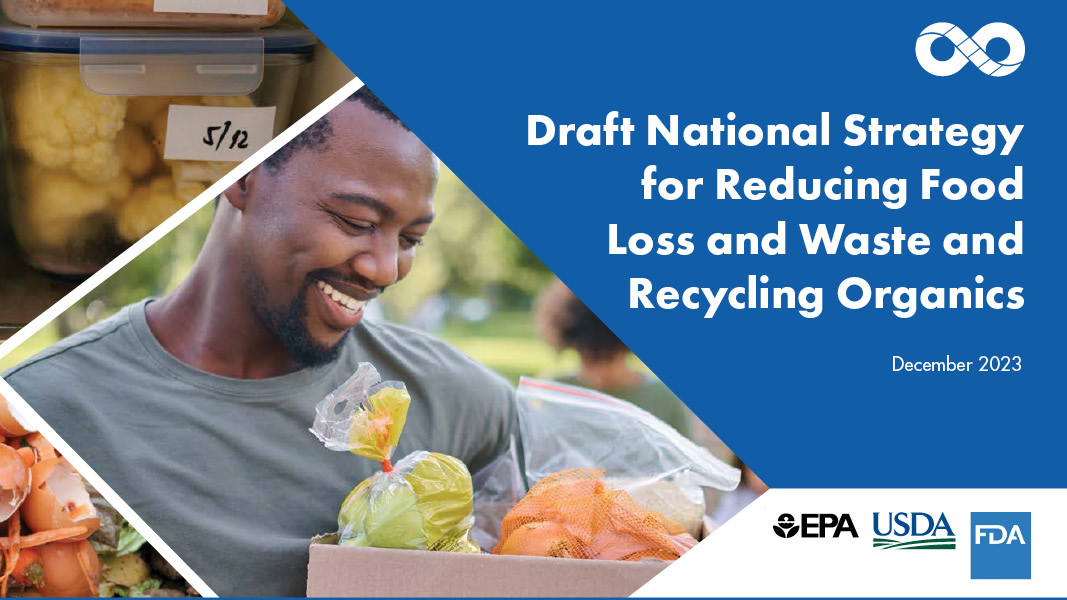On December 2, 2023, the U.S. Environmental Protection Agency (EPA), the U.S. Department of Agriculture (USDA), and the U.S. Food and Drug Administration (FDA) released the “Draft National Strategy for Reducing Food Loss and Waste (FLW) and Recycling Organics.” The Strategy is open for public comment, starting December 5, for 30 days. (Share comments through Regulations.gov, Docket ID No. EPA-HQ-OLEM-2022-0415.) The Strategy outlines targeted actions by USDA, EPA and FDA to prevent FLW in order to mitigate the environmental repercussions of wasted food, including its impact on climate. “Food loss and waste poses a real challenge to agriculture, food and the climate,” said Agriculture Secretary Tom Vilsack. “To tackle this problem, and in turn build a resilient food system and mitigate climate impacts, we must explore and implement innovative solutions. This joint effort between USDA, EPA, and FDA will enhance interagency coordination and represents a vital step towards preventing FLW, increasing organic waste recycling, and promoting economic opportunity.”
The announcement was made at COP28, the 2023 United Nations Climate Change Conference, and advances USDA’s goals to enhance agriculture’s ability to address global food security, manage the consequences of climate change, and engage in innovative practices. This strategy is a deliverable in the Biden-Harris Administration’s National Strategy on Hunger, Nutrition, and Health, released in September 2022.
Four objectives are set forth in the draft strategy: Preventing the loss of food where possible; Preventing the waste of food where possible; Increasing the recycling rate for all organic waste; and Supporting policies that incentivize and encourage FLW prevention and organics recycling. For each objective, the draft strategy highlights actions that USDA, EPA, and FDA could take. Some of the priority USDA actions include:
- Investing $30 million in the Composting and Food Waste Reduction (CFWR) Cooperative Agreements;
- Expanding partnerships with the National Institute of Food & Agriculture food system programs to further develop educational materials, research and outreach for food loss and waste prevention;
- Funding research and development on innovative new packaging technology to extend the shelf life of food and prevent loss; and
- Continue outreach to businesses on the liability protections afforded by the Bill Emerson Good Samaritan Food Donation Act.
The introduction in the draft strategy highlights seven key challenges that must be overcome to prevent half of FLW (National Food Loss and Waste Reduction Goal) and to recycle half of all waste, including food and other organic waste (National Recycling Goal): Limited outreach and education; Limited fundamental research funding; Need for collaboration; Obstacles facing underserved communities; Insufficient infrastructure and planning; Organics recycling market expansion; and Obstacles to estimating FLW and progress toward goals.
The Biden-Harris Administration is seeking input during the public comment period from individuals and partners on what federal actions should be included or modified in the Strategy and how best to collaborate on those efforts with partners across all sectors of society — local, state, Tribal, and territorial governments; professional and industry associations; individuals, private companies, and those working in food and agricultural industries; academic institutions; and non-governmental and community-based organizations. In many cases, this Strategy builds upon the successful work and input of these partner organizations, notes the draft. Comments received on the draft will be addressed, with implementation beginning in 2024. “EPA will use the Bipartisan Infrastructure Law’s materials management grants, and other resources available, to implement actions in this Strategy as appropriate,” states the draft. “Specifically, under the law, at least 40% of these investments, as part of the Justice40 initiative, will fund projects that benefit disadvantaged communities. USDA will use American Rescue Plan Act (ARPA) and Inflation Reduction Act (IRA) funds, capacity, and competitive research, education, Extension funding, and other resources available to implement actions, as appropriate to their authority.”













